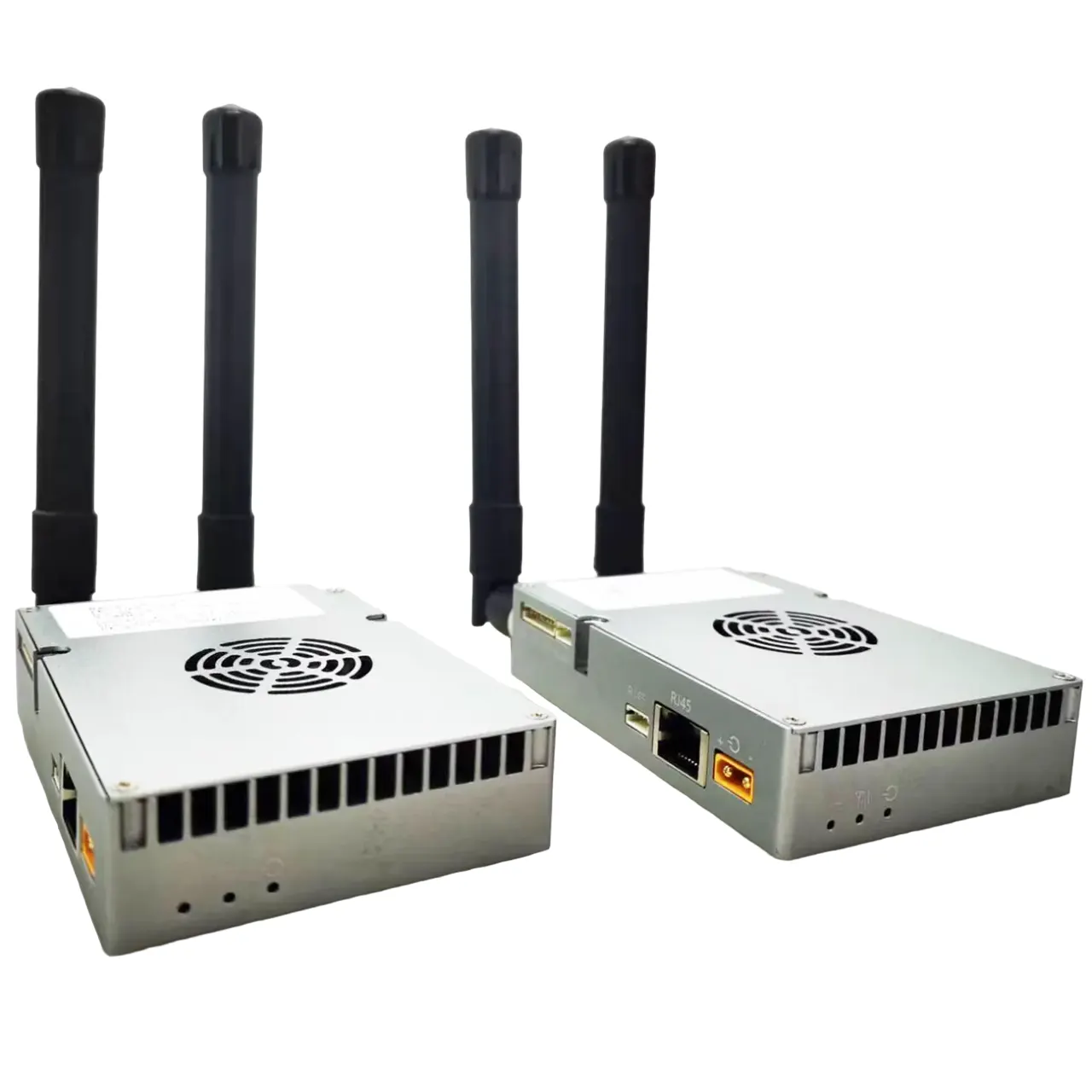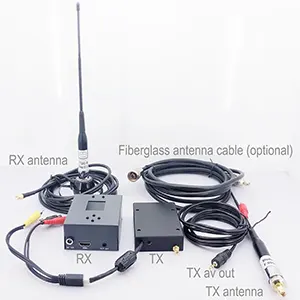Drone repeater solution of long-range wireless video transmitter and receiver TX900-10W PA

Table of Contents
repeater model for one-way video data transmission unidirectional
For the one-way COFDM Video Data Transmission repeater, we recommended the model Vcan1886, Which has built-in RX (receive) and TX (transmit) two functions, it can get video and data from your transmitter, and send video and data to your receiver, This module has two frequencies, one frequency is as the receiver frequency, it is the same with your transmitter, another frequency is as the transmitter frequency, it is the same with your receiver.
We also can customize the repeater/relay for you. To avoid interference, we also add the two filters, like the below picture.



Repeater/Relay solution for two-way video data transmission bidirectional
TX900-10W PA introduction and solution as the Drone repeater
TX900-10W PA power amplifier supports drone repeater and FHSS function. Let me introduce the details below.
1. TX900 consists of a core modem (Vcan1681, two-way wireless video, and data link module) and a 2-watt, 5-watt, or 10-watt RF power amplifier inside. (a core modem and 2-watt PA inside picture)
2. There are two versions of the core modem (the same hardware with different Soc firmware): The star wireless network version and the Mesh wireless network version.

| Part number | Frequency band(MHz) | Network type |
| K150 | 1420~1530 | Star wireless network version. (P2P, P2MP) It can be used for point-to-point transmitting, point-to-multiple point transmitting, and one-node relay transmitting. The maximum transmitting distance between two points is 150km. |
| S150 | 806~826 1427.9~1447.9 2401.5 – 2481.5 | |
| MK50 | 1400~1529.9 | Mesh wireless network version. Mesh network mode. The maximum transmitting distance between two points is 50km. |
| M50 | 806~826 1427.9~1447.8 2401.5 – 2481.5 |
Only the same core modem can communicate with each other, different core modems can‘t communicate with each other.
3. 10-Watt RF power amplifier is available for 806~826MHz, 1427.9~1447.9MHz, 2401.5 – 2481.5MHz, 1420~12470MHz, 1470~1530MHz. So, we can have TX900-10W to work in 806~826MHz, 1427.9~1447.9MHz, 2401.5 – 2481.5MHz, 1420~12480MHz, 1470~1530MHz.
To note, For the 1420~1530MHz band, we need to separate it into two sub-bands (1420~1480MHz, 1470~1530MHz) since the 10-Watt RF power amplifier can’t support the whole 1420~1530MHz band in the same hardware board.
4. 1.4/3/5/10/20MHz bandwidths configurable, the larger working bandwidth supports more transmitting bitrates in the same condition. For 150km video transmitting, we suggest using 20MHz bandwidth (at least 10MHz).
5. For TX900-10W(1420~1480MHz) or TX900-10W(1470~1530MHz), when setting the working bandwidth is 20MHz, it has about 6 central working frequency points; when setting the working bandwidth as 10MHz, it has about 12 central working frequency point;
The central working frequency will hop when it detects frequency noise. If the current working frequency channel is clean, it will not hop. That means the frequency hopping is not as regular as x times/second.
6. There are two solutions for 150km+150km relay transmitting:
Solution A:

Solution B:

We suggest solution A since it supports more bitrates transmitting than solution B. It is more reliable on video transmission when the RF signal is weak (low SNR).
On Oct. 25th, we tested solution B. During the testing, it had little RF noise on the seaside and we can see A Mobile communication base station tower just about 100m nearby.
Signal reporting on the seaside:

We can see the SNR is about 2~4 on the seaside.
Signal reporting on the mountainside:

We can see the SNR is about 4~7 on the mountainside. The different SNRs on the two sides also approved that it had little RF noise on the seaside.
However, the video was transmitted very fluently with little RF noise.
Star Networking Vs Mesh Networking for Drone or Robot.
| STAR Network | MESH Network |
|---|---|
| Point to Point Connection between nodes | Multi-point to multi-point connection between nodes |
| Infrastructure based | In Ad hoc mode, devices are autonomous and free to move. In Infrastructure mode, the movement of nodes is restricted around the control center. |
| Central control point is present | Infrastructure-based will have a control center whereas Ad hoc-based does not have it. |
| Nodes communicate via the control center. | It is self-configuring. |
| The central control point is present | Multi hop communication |
| Devices or nodes can not move freely. | Infrastructure-based will have a control center where as Ad hoc based does not. |
| Links between nodes and central control points can be configured. | In Ad hoc mode, devices are autonomous and free to move. In Infrastructure mode, the movement of nodes are restricted around the control center. |
| Nodes communicate via the control center. | Nodes relay traffic to other nodes on the path. |
Technical Specification for the Repeater from one client
- It is required to create an SBus video/data/signal transmission system with a relay station installed on a hexacopter and GC.
- We need the ability to switch frequencies in the range from 800 MHz to 1.4 GHz for SBus data and video transmission (analog and digital with minimal delays).
- Sector antenna for adjusting the gain of the transmitted/received long-range signal. The ability to work with 5 receiving nodes. Support for Ethernet and UART connections between the repeater on the hexacopter and Ground Control requires a real-time image for the operator. The ability to work with 5 receiving nodes. Support Ethernet and UART connection between helicopter repeater and GC, requires a real-time image for the operator.


1. Is your system capable of using 3 nodes? We have to use 3rd node as the repeater in the center between the transmitter and receiver.
Yes, it supports.
2. If I use two drones, one is a transmitter, another is a repeater, and they are controlled by one receiver. Does TX900 support to control of the mission plane and relay drone?
Yes, there are three solutions to do that.
TX900 has three data ports. Distinguish through different transparent serial ports, such as D2 to control relay aircraft and D3 to control mission aircraft. The disadvantage is that the TX900 receiver needs to be connected to two serial ports to send instructions separately.
Use the same transparent serial port to send data in bulk, and then add layer protocols (such as header information) to the data to distinguish which aircraft should receive and process the data. The disadvantage is that the processing of sending and receiving data is complicated.
Or use two receivers: One receiver is for the mission plane (transmitter), and another receiver is for the repeater drone. The connection and operation are easier.
3. Our company “Boat-Sharing” is engaged in the development of pleasure boats with remote control.
I ask you to give a commercial proposal for the development and sale of a remote control system with a relay system through a pilot-free aircraft at a distance of up to 200 kilometers. In addition, the boat must be equipped with a video camera with a video transmission system to the base station.
Our TX900 supports 10-watt PA 150km. It also supports relay if you buy three units. (One as transmitter, one as receiver, another as the receiver)
4. Is it possible to quickly change the operating mode (during the flight) of the repeater between point to point?
Sorry, it can not. You can change the role of the transceiver to the transmitter, receiver, or repeater on the ground.
5. If we stay under 30Km LOS and 50Km with Repeater. Kindly share the transceiver datasheet so my team can better understand the Ports and interface available. We would also need RSSI and telemetry.
Is your quotation bundled with antennas?
Yes, our TX900 supports 30km LOS and 50km with repeater. (max 150~200km)
TX900 supports to show you real-time RSSI and telemetry.
Our quotation includes the four antennas. (two short antennae for the plane in the air side, two long antennae for the ground receiver)
6. Hi, please check our request about the transmitter, receiver and repeater.
Hi, interested in radio communication (rx and tx)for UAVs at frequencies of 300-320MHz or non-standard frequencies that you can offer us, we also need matched antennas for them.
And the ability to connect to the Radiomaster tx16s remote via twisted pair or USB.
To spread the remote control and the transmitter at a distance.
The range of radio communication should be at least 10 km with a very noisy radio broadcast.
Interested in a video transmitter and a video receiver at frequencies 2.1 – 2.2Ghz, and 4.8 – 4.9Ghz or non-standard frequencies that you can offer us for use on UAVs. Also matched antennas to them. Video receivers can connect either an AV cable, Fatshark, or sky zone glasses, or the ability to manufacture a ready-made helmet with a video receiver for these frequencies. Video Transmitter: Smart Audio support: yes
Dimensions: ~40×23×10.5mm
Weight: ~15 g.
Repeater. Product requirements: must transmit radio (300 – 320 Mhz) and video (2.1 – 2.2 or 4.8 – 4.9 Ghz) communication on the same frequencies as previously requested. Or non-standard frequencies that you can offer us. The input voltage is from ~5 to 30 volts. As well as matched antennas to the kit.
Thanks.
7. Do you have a wireless video transmitter, receiver, repeater, or relay for the forest?
Have you already tested your radio system inside the forest? I’m asking this for you because if you’ve already tested this, your experience will help a lot in my research.
Our idea is to stay at a fixed point outside the forest with the transmitter and control the ground robot, fix the receiver on the ground robot, and send it to the forest. We have developed another device that we are going to place on top of the treetops with a drone, and in this device, we can place the signal repeater that you have said you have.
Could you send me the radius models that you have available for this purpose and the technical specifications for me to check, please?

For the ground receiver, D1 is a TTL serial port: black is GND, yellow is RX, red is TX
D2 and D3 are Sbus in interfaces: black is GND, yellow is Sbus in, and red is floating.
- Ground Receiver ( default IP is 192.168.1.13, access node)
D1 is TTL, D2, and D3 are Sbus in (black is GND, yellow is Sbus in, and red is floating); - Aircraft Repeater / Relay ( default IP is 192.168.1.11, central node, also called relay)
D1 is TTL, D3 is Sbus out (black is GND, yellow is Sbus out, red is floating), D2 is useless; - Unmanned Ship transmitter ( default IP is 192.168.1.12, access node)
D1 is TTL, D2 is Sbus out (black is GND, yellow is Sbus out, red is floating), D3 is useless;



bi-directional optical system for drone li fi, FHSS полудуплекс, коптер-ретранслятором, передача hdmi на 15 километров комплект оборудования, передача hdmi на 15 километров комплект оборудования, OFDM – XP 4000, видео модем для фпв 10 км цифра, передача видео с дрона плаз,






I’m looking for a long range repeater for a wifi drone like the tello which I can control via phone
Thanks. We don’t off the repeater drone. We just offer a complete drone repeater solution, including the drone wireless video data transmitters, repeater, and receiver.
Our products are suitable who want to design and assemble the drone by themselves. It is not suitable for using already drone systems, like the DJI Tello drone.